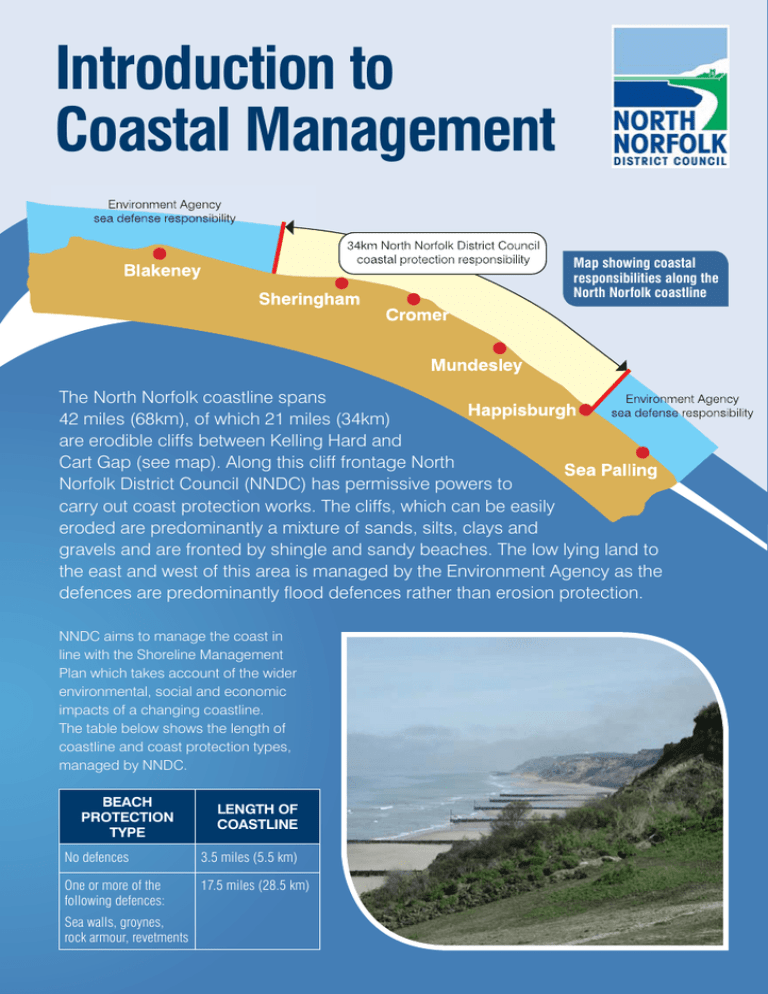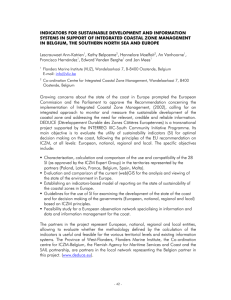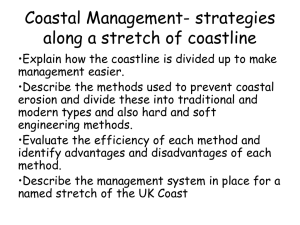North Norfolk Coastal Management: An Introduction
advertisement

Introduction to Coastal Management Map showing coastal responsibilities along the North Norfolk coastline The North Norfolk coastline spans 42 miles (68km), of which 21 miles (34km) are erodible cliffs between Kelling Hard and Cart Gap (see map). Along this cliff frontage North Norfolk District Council (NNDC) has permissive powers to carry out coast protection works. The cliffs, which can be easily eroded are predominantly a mixture of sands, silts, clays and gravels and are fronted by shingle and sandy beaches. The low lying land to the east and west of this area is managed by the Environment Agency as the defences are predominantly flood defences rather than erosion protection. NNDC aims to manage the coast in line with the Shoreline Management Plan which takes account of the wider environmental, social and economic impacts of a changing coastline. The table below shows the length of coastline and coast protection types, managed by NNDC. BEACH PROTECTION TYPE LENGTH OF COASTLINE No defences 3.5 miles (5.5 km) One or more of the following defences: 17.5 miles (28.5 km) Sea walls, groynes, rock armour, revetments Overview of the coast Coastal erosion of the soft cliffs in North Norfolk is a natural process which has been going on for thousands of years. It was only in the late 19th century that substantial sea defences were constructed in the larger towns on the coast. Many of the current defences, in the form of groynes and revetments were constructed after the Second World War, particularly in the 1950-60s in response to the great flood of 1953 when over 300 people along the east coast lost their lives. The most recent Shoreline Management Plan (SMP) recognises that the continued maintenance of sea defences is considered neither affordable nor environmentally sustainable. Hard defences prevent erosion of cliffs, reducing the amount of sediment being transported and deposited on beaches further down the coast. This results in lowered beach levels and increased exposure of sea defences which makes them more vulnerable to damage and less effective barriers to erosion. However, the publication of the SMP was highly controversial as it signalled some policy changes from “Hold the Line” to “Managed Realignment”. Following concerns, ‘social justice’ was included in the SMP but it is not yet understood how such changes in policy can be implemented as ‘coastal adaptation’ is not currently a coastal management option funded by government. Holkham to Weybourne This stretch of coast consists of an extensive shingle bank fronting low-lying wetlands designated for their environmental importance. To the west there are extensive dunes fronted by wide and shallow sandy beaches. The North Norfolk coast is recognised for its beauty and biodiversity and areas has been declared as an Area of Outstanding Natural Beauty (AONB), with Sites of Special Scientific Interest (SSSIs) and designated areas of international environmental interest. Weybourne to Cromer Sheringham and Cromer are two of the main towns on the North Norfolk coastal frontage. They are traditional seaside towns with many tourist attractions and will be protected for the foreseeable future due to their local economic value. The wider area of this frontage has protection for key beach access points but is largely natural. East Cromer to Cart Gap Happisburgh This long length of cliff frontage is rural in nature and interspersed with settlements such as Mundesley and Walcott, and key national infrastructure at Bacton Gas Terminal. Much of the agricultural land is rated between grade one (high quality) and grade three (medium quality). Coastal erosion is most active along this stretch and the cliffs provide much of the sediment for beaches further down the coast. Over time, houses, businesses and communities will become more affected if sea defences are not in place and a way forward for managing a changing coastline will be required. The policy for this area varies but is a mixture of ‘Hold the Line’ and ‘Managed Realignment’ in the short and medium term. More information can be found for specific areas in the Shoreline Management Plan. Cart Gap Happisburgh to Horsey This is a low lying frontage with sandy beaches backed by a sea wall and dunes. In the past, beaches have become starved of sediment and a large coast protection scheme was developed to protect the frontage in order to manage the likelihood of extensive flooding of the Broads. Key coastal issues The coast is, and will continue to be a popular and pleasant place to live, but there are issues that need to be understood in order to make decisions and manage the coast appropriately. These key issues are outlined below: Reducing beach levels - Beaches limit erosion by absorbing the energy of the sea, however, across the east coast, beach levels are generally reducing. This exposes cliffs and defences to a greater action from the sea. Further to this, sea level rise and increased storm events resulting from climate change are likely to impact on erosion rates and in turn put increasing pressure on sea defences and coastal communities. For more information on this process, please see the Tides, Waves and Beaches factsheet. Coastal Management Funding - Funding for coastal management from central government is limited and highly competitive. The North Norfolk coastline is largely rural and it is difficult to attract government funds when there are other urban areas at risk that seek protection also. Currently there is no dedicated source of funds to assist communities adapt to coastal change, however such schemes are vital if we are to manage the coast. Changing coastlines A changing coastline as outlined in the Shoreline Management Plan will have implications on property owners and communities. Some agricultural land will continue to be lost and there may be negative and positive impacts on the natural environment. Beach access may become more difficult as cliffs retreat, and where sea defences remain, beaches may become smaller and steeper. Where the coast does realign, beaches are likely to become broader, more open and possibly better suited to recreation. Where the coast seeks to continue to change as it has done so for thousands of years, it will be essential to manage the change and assist those who may become affected. This will only be achieved by all those involved working together. Introduction to Coastal funding All approaches to coastal management require some form of funding. Current funding sources are outlined below: Grant in Aid Large scale coast protection schemes can potentially be funded through central government (via the Environment Agency). The benefits of a scheme are compared with the costs in a cost-benefit analysis so that schemes from across the region can be compared and prioritized. There is a limited amount of funding available and it is highly competitive, often “partnership contributions” (local contributions) are required for the scheme to go ahead. Due to the rural nature of the North Norfolk coast, few locations are likely to receive funding through this route. Revenue funding Each year, the Council receives funding from the government as part of an annual Revenue Support Grant to help pay for local services. Approximately £340,000 per year is allocated for the maintenance of the existing sea defences in North Norfolk. Funding for local government is in a period of change with continued pressure across council budgets. The East Anglian Coastal Group (EACG) has developed a toolkit explaining partnership funding. To find out more please visit www.eacg.org.uk/default_partnership_funding Private funding Coastal management can be funded or part-funded by businesses and communities. It has been carried out in the past and can work well. Other funding North Norfolk District Council is always seeking alternative sources of funding for coastal management. The future` NNDC is committed to seeking a sustainable coastal management approach for the North Norfolk coast. This will involve continued coast protection where practicable, however, it is likely that it will not be environmental sustainable or financially viable in some locations. In those areas there is a need to develop measures to enable communities and individuals to adapt. NNDC, with local communities, has trialled adaptation approaches which work. The challenge is now to develop and fund longer term plans to minimise negative consequences of coastal change and to enhance the local environment and economy. Coastal Management Policy Coastal policy shapes how the coast is managed in terms of what is done and where. Shoreline Management Plans (SMP) outline the policy for individual areas on the coast. Shoreline Management Plan The Shoreline Management Plan (SMP) is a policy document which outlines the risks posed by coastal change and an overview of how this should be managed. It is a non-statutory document which forms part of the Department for Environment, Food and Rural Affairs (Defra) strategy for flood and coastal defence. The plan provides a large scale assessment of the risks experienced by people and the environment, aiming to manage them in a sustainable way. Each SMP is specific to an area which is usually based on a natural process unit (sediment cell or sub-cell). It provides guidance for coastal management actions. To find out more about the Shoreline Management Plans for Norfolk, visit www.north-norfolk.gov.uk/environment/. For information on SMP’s from around the country, visit www.gov.uk/government/pulications/shoreline-management-plans-smps. The coastline within each SMP is sectioned into policy units, which are small sections of the coast (e.g. Policy Unit 6.08 – Mundesley). Management policies are defined for the short (to 2025), medium (2025 – 2055), and long (2055 - 2105) term. These management options (outlined in the table below) influence decisions made on the coast. Any coast protection scheme is expected to align with these policies. Walcott storm Damage 2014 repairs Hold the Line Includes maintaining or renewing current sea defences and in some cases implementation of extra defences. Managed Realignment Allowing the shoreline to move as it would naturally, while minimising impact and keeping remaining defences safe. Do nothing/No active intervention There is no investment in coastal defences. Development of Policy Policy is periodically reviewed and utilises the most up-to-date information available including coastal models which help to predict future trends and erosion rates. These are combined with other data, such as the condition of current defences and climate change predictions. This allows for a better understanding of the possible impacts and options for the coast. When making decisions as to what coast protection schemes to fund, central government often refer to a ‘cost benefit analysis’ which compares the costs of a scheme to the benefits of the protection. North Norfolk is a rural area and this means that it is often difficult to demonstrate enough benefits to justify coast protection funding compared to more urban areas. As a result, it is often difficult for North Norfolk District Council to access central government coast protection funding for many locations along our coast. However, North Norfolk District Council continuously investigates potential funding avenues for coastal protection as ‘doing nothing’ is not a ‘no cost option’. For more information concerning the coast, visit www.northnorfolk.org/environment. Or contact the Coastal Management Team: Tel: 01263 516248 Email: Coastal.Management@north-norfolk.gov.uk l North Norfolk District Council Holt Road, Cromer, Norfolk, NR27 9EN If you would like this document in large print or an alternative format, please telephone 01263 516150 and we will do our best to help.






